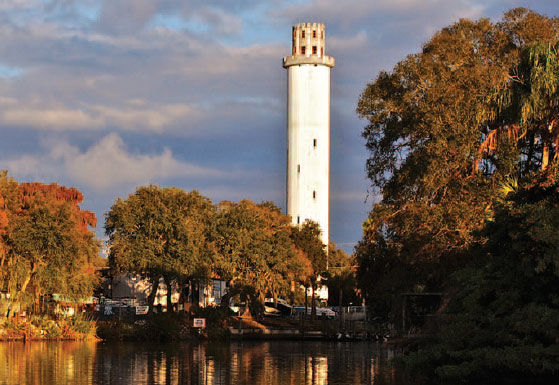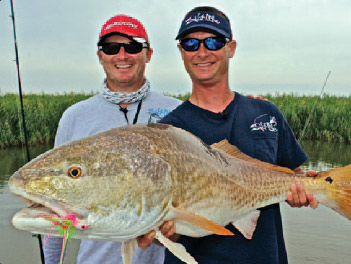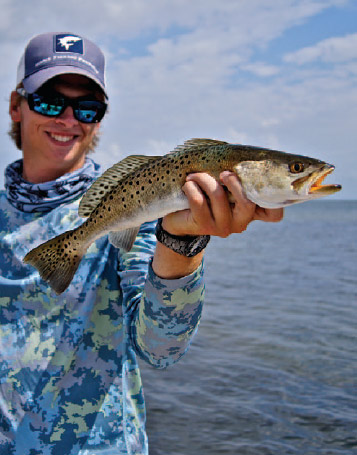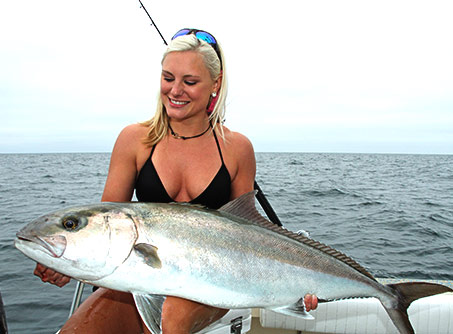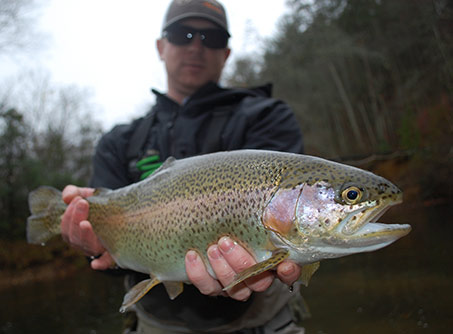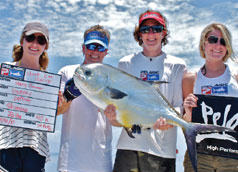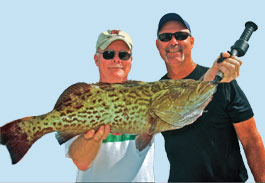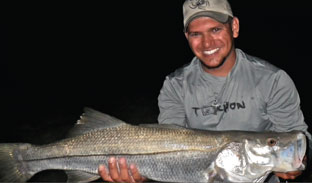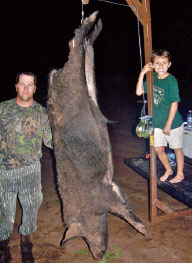The roots of my family tree are anchored in the soil of Tampa and Ybor city from the 1950’s. I have been running a lot of my trips from downtown this winter so I thought I’d tell you about some of the cool but frequently overlooked things to do and things you might see by boat near where the Hillsborough river falls into the large estuary of Tampa Bay.
I tie the boat up and run the majority of my trips out of Ricks on the River. Ricks has ample parking, cold beer, good food and the setting is just north of the downtown Tampa skyline. Rick’s is the perfect place to return after battling fish and surviving an adventure. I have, on many occasions, watched the tide run out of the river as the sun was sinking on the day while sitting at Rick’s. The crowd is mostly locals, a couple of halfwit (or is it half lit) guides, like myself and Capt. Wes Burns, river rats, attorneys, professional athletes, old friends, new ones and people from all walks of life. We all gather at the outside bar to tell lies and laugh at our lives. Eddie can be found sitting on the corner of the bar most every afternoon, while Rhonda, Crystal, Stephanie, Alison and Jessica keep the drinks and food flowing from the inside and outside bars. Tip’em well, they work hard! Ricks also has a ramp where I have unloaded my 22’ bay boat on a negative low tide with no problems. Its 10 bucks to launch and 100% of the ramp fee goes to fight juvenile diabetes, so don’t skip out on it. Rick’s is a great place to leave from and an even better one to come back to.
For those wanting to try something new or different, Urban Kai is a paddleboard shop next to Ricks; they offer sales, lessons and rentals. They do a Sunday morning yoga session using the paddleboards on the water at Davis Island. The Davis Island Ramp has also been refurbished and has new docks. It’s still free to use and it’s just a short little jaunt into the bay or a great launch point to ride the river.
I have done a few sunset cruises through downtown. The ride out is pretty cool, the sea walls are all adorned with different college crew team logos and slogans. Nearly all of my clients make mention of it. The ride through the Garrison channel is slow, but very relaxing. This trip just makes me wonder how people acquire the massive amount of cash it takes to own those homes, for me it is not comprehendible , especially on a guides income. The sun setting over the horizon of St. Pete is at times breathtaking and after dark it’s beautiful. The bridges are all lit up in different shades and colors. The skyline is aglow with all the lights and buildings illuminating the skies. It’s kind of eerie, the hustle and bustle of the downtown night crowd is all around you, yet the sense of being alone out on the water is overwhelming. I pick up a lot of my sunset cruises at the dock in front of a quaint little Italian restaurant called That’s Amore’. I will make reservations for you there and have a chilled bottle of wine to toast the indescribable ending to a fantastic journey, whether it is a first date, anniversary or just because.
While running the shipping channel be on the lookout for the large Tugboats. When you see the ones running hard pushing water in front, keep watching, the dolphins love to play in the wake, they jump, spin and for whatever reason really like to play right in front of the tugs. It’s really awesome to witness the athletic ability of these mammals. The ever watched over sea cows can be found in the warmer waters by the power plant soaking in the warmth and basking in the sun. Pine Island ( A.K.A. Beer Can island) is just a little south of the Alafia River. It is a neat place to hang out and enjoy the day with friends on an island that is only accessible by boat. Be sure to take your trash with you when you leave and pick up any stray trash that is laying around, that way the powers that be will allow this resource to be enjoyed and it’ll keep it looking good to the next set of boaters.
The fishing downtown is different than anywhere else I have fished in the bay. It’s tougher, but more rewarding. Winter was good, lots of sheepshead and tons of docks and structure to hold them. Occasionally when we have a warm winter night, the snook can be caught around the dock lights. It’s a part of the bay many have not seen, it’s a little on the industrial side in places and a little on the commercialized side with all the buildings and channelside. Oddly enough it is just like the residents of Tampa, diverse.
Kinda off the subject of this article, but I want to say thanks to my clients. It’s through their eyes that I have rediscovered that many things that are routine for me are brand new and exciting to them. It’s worth the time to slow it down and ride the tide. Looking back over the time since I began fishing professionally, I have witnessed some awesome sights, amazing creations and many things of indescribable beauty. I am so very fortunate to have a really neat career that offers occupational hazards like seeing more than my share of sunrises and sunsets. I love smelling the aroma of the salt air or the freshly washed atmosphere after a summer storm, before it gets heavy with humidity again. I am fortunate to see Dolphin and Manatees daily and to have on file all the mental images of the many tides that brought in with them some awesome people. Many of the inspirations for my stories and thoughts, some of which have been printed here come from these experiences. You have all affirmed my belief there is a God and I am convinced he is an artist.
To experience an adventure on the water, give Captain Tim a call, text or email. Who knows you may find your story here, in the pages of next month’s Onshore-Offshore magazine! Cell: 813-714-0889 and email: tim@swiftfishcharters.com.
DOWNTOWN ON THE WATER
The Running of the Bulls
Pamplona is not the only place in the world you can experience the running of the bulls. Now what I am referring to has nothing to do with the bulls of Spain; however, it is still the experience of a lifetime!
The southern Gulf Coast has some of the best inshore sportfishing in the world and one of the most sought after species is the Bull Redfish. My home, the Louisiana Gulf Coast, from the Cities of Slidell to Lake Charles and everywhere in between is a Mecca for what I refer to as the “Running of the Bulls”. There are hundreds of guide services and outfitters that are ready to take you out and target this species in any way that you like.
Redfish can be caught year round. Usually, where you find one you will find many. In most cases, schools of hundreds or even thousands of fish can be found working flats and sand bars following masses of bait. The slot for legal redfish in Louisiana is 16” to 27”, with a 5 fish limit per angler. Any fish exceeding the 27” maximum is considered a Bull and you are only allowed one of them in your limit.
It doesn’t take a professional angler to target this species. There are numerous techniques and methods to catch these monsters. Redfish are extremely aggressive predatory fish, feeding on all types of small baitfish and crustaceans. Their aggressive and curious nature makes them a sought after target for local guides, not to mention that they make high quality table fare.
Some of my favorite methods to catch Bulls are top-water plugs, sight casting jigs and on a fly rod. I recently had the opportunity to host Captain Jimmy Nelson from Extreme Fishing Adventures. I was fresh off of a couple of tournament wins and I had a great feel for where the “Running of the Bulls” was going on!
We began our adventure by departing Venice, Louisiana via Venice Marina. This region is a particular favorite of mine due to the vast prolific brackish water estuaries that the Mississippi River delta produces. The vast area of fishable waters, high volumes of bait and large numbers of quality fish makes it a stop I recommend for any thrill seeking angler.
This was Captain Jimmy’s second time fishing with me in the past two years. Our first trip was a success and a great show, but we were not able to land that true trophy Bull in the 45 – 50 pound class. This year, I was prepared for everything. We started our first day on a large tidal flight tucked back against the Roso Canes. On this trip, we decided to target the Bulls using Yo-Zuri 3D poppers and Salt life jigs. Unlike the previous year, I made sure Captain Jimmy brought enough plugs to get us through the day.
On our previous trip, several of the Bulls were so large that they literally pulled the hooks of the plugs we were throwing. Because of this our bait of choice was the Yo-Zuri Sashimi and 3D Poppers. This is a plug that is widely used for offshore species like Tuna and Dolphin/Mahi. We used this plug with great success and no failure. Upon arrival to our first spot, the tide was perfect and the Bulls were running. There were bait ball explosions all around us. Jimmy made a long cast and soon after he started working the plug with its chugging action, a 30+ lb. Bull “greyhounded” on it. I wasn’t far behind and I doubled him up. What a great way to start the day, a double totaling well over 50 pounds of fish. The day continued as it started and we managed to catch close to one hundred fish in two days, easily going over 2000 lb. in total weight. We had several fish in the 40 lb. class and even managed to catch one of my personal bests, a 53 pounder. I can’t say that every trip is like, this there are always variables involved, however, even if you just get to catch one of these monsters it is a trip to remember.
If you have any interest in experiencing the Gulf Coast “Running of the Bulls” contact me, Captain Sean O’Connell or my partner, Captain Eddie Adams at www.LouisianaRedfishMasters.com.
Read this article complete with all imagery in the Onshore Offshore digital flipbook by clicking here.
In Deep Part 2
This is a continuation of an article from the January Onshore Offshore. As we rejoin the happy anglers, Capt. Johnny Touchton and his good friend Capt. Tim Whitfield, they are fishing deep in the heart of the Chokoloskee wilderness.
“I’m looking for the really thick linesider that was lurking up close to the groves.” I told Tim. “She had to be close to twenty pounds,” I continued. Tim agreed. We poled the rest of that side of the bay without seeing as much as a creek chub or killifish.
As we rounded one of the corners, into a bend that was previously obscured from view, an osprey launched itself off one of the many mangrove branches and sailed just across our bow. It called to
its mate off on the hunt.
“I don’t see a thing. The bay looks lifeless.” Tim said after some time scanning the water’s surface.
“I suppose we could blind cast. I mean, that first fish ate completely at random and neither of us saw her.” I said while resting for a moment atop the platform. Tim began false casting his line and began a search pattern of the shallow water, beginning from 1 o’clock and working counterclockwise towards the edges of the groves. This continued for the better part of an hour to no avail.
“That old man was full of crap if you ask me. One lousy damn snook for all the work it took to get back here; it’s just not worth it.” I said out of frustration. “Why don’t we break for lunch? I need to eat something.” We sat down on the front deck and Tim popped open the Yeti. A couple of bologna and cheese sandwiches came out along with an ancient handle of rum.
The dark bottle was still half full, but had been in the cooler for so long that the paper label had long since rubbed off. I packed my Tervis with ice and put plenty of the blackstrap rum and coke in it. I finished it off with a lime wedge cut from a fruit bobbing in the cooler. Tim followed suit and we rested while the ospreys called and the herons looked on.
The cool breeze that had been up in the canopy the whole time finally fell down into the bay and pushed our small craft to the opposite end. As I looked up from my drink, I realized that the bay continued back even further than previously thought.
The twenty acre bay had now tripled in size and in the far back corner I could see a large canal where there were copious numbers of mullet attempting to take flight, only to wind up falling back into the blackwater, thanks in no small part to gravity. With my sandwich eaten, I topped off my drink and finished it with more lime, then hopped back on the platform to push Tim up to try the new area.
“I’ll play the wind and stake us out on the edge of those mullet so you can blind cast into the school. See where they stretch out on the flat from the inside of that canal?” I waited for Tim’s response.
“Yeah okay, I got them. You think this dark zonker will continue to produce?” He asked, mostly out of boredom from throwing the same fly for the better part of the day.
“Yeah I don’t see why not. It worked on that snook earlier and when you eye it in the water it looks almost exactly like a dark creek chub. I’d try it for a few minutes in the school of mullet and if it hasn’t produced then we can switch it out.” I answered.
We never got the chance to switch the fly out, for among the mullet, lay everything from Jack Crevalle, to big winter trout, to redfish snooklets gorging themselves on the shrimp and crabs stirred up by the big school of smoke-ready fish. The next three hours were a blur as we continued to catch fish after fish on nearly every cast. None of the fish had much size to them, but when you get to take part in a fishing melee such as this, you don’t complain too much about the size of the fish caught and released. As the bite died off after a while, we picked up our spinning outfits to sooth our aching shoulders from casting the long rods all day. After seeing the juicy rubber presentations cast at them, the blitz continued.
The waning day crept up on us and soon we were having difficulty seeing beyond the bends of the bay. With no cell service and the GPS not working properly, we found ourselves in a rather serious situation. On the trolling motor, Tim sped us along the shoreline where we thought that we had started the day. I stood atop the platform to look for anything that might give us a clue as to our whereabouts. I had just looked up from my phone, which still read, “No Service,” when I caught a glimpse of something manmade. I informed Tim, who directed us towards the wood laden structure.
We had stumbled upon an abandoned chickee that so often dot the canals and bays of the Everglades. The structure had been obscured from our sight the whole time we had been fishing and only through our desperate search for an exit did we find it.
“Well…I’ve slept in much more uncomfortable places before, though I cannot remember when or where.” I said aloud.
Tim just smiled as he reached into the front deck of the Action-Craft and pulled out mosquito netting and a couple of lightweight hammocks, along with kerosene lamps and a cook stove. He looked up to my eyes which I’m sure were as wide as a deer in headlights. Tim finally said, “I planned for this. I know how we get when we are fishing, and figured I would come prepared.”
I laughed at the notion and thanked him for his foresight into our recklessness. We tied off the boat and climbed up. Upon the last plank of the ladder there was a message etched into the wood. It read: For the forlorn and the hapless. – A.W.
We couldn’t help but laugh as we strung our hammocks and cut up the redfish that we had planned on searing in a cooking pan in the air conditioning, rather than over a camp stove fire in the wilds.
Amongst the cicadas, raccoons, mullet splashes and the ospreys calling from above, I do believe
we never slept so soundly or were more at peace. To be continued…
If you would like to experience a fly fishing or light tackle expedition such as this one, do not hesitate to give Capt. Johnny a call. With thousands of pristine miles of backwater to choose from, your experience will be as legendary as meeting Alligator Willie. Call 813-713-0237 or email lpineoutdoors@gmail.com.
Read this article complete with all imagery in the Onshore Offshore digital flipbook by clicking here.
Tenacity
Tenacity is an admirable quality that is essential for a long successful life. Anything worth doing takes persistence and perseverance. A great fisherman will keep trying until the goal is attained and a tenacious fish will keep fighting until you defeat it. There might be some differences between humans and fish (I’ll leave that to the ichthyologists) but I can comfortably say that most of us will give up before the fish do. If we lived our lives similar to fish, the overall human population might be a little healthier. Fish eat health, exercise daily, travel seasonally, fight for their lives and run when there is danger. There are some exceptions to a few of those features (hogfish and grouper) but snook, tuna, tarpon, and amberjack are undoubtedly a few very tenacious species.
First and Foremost: Do the right thing!
Right vs wrong, good vs bad and ethical vs immoral are constantly moving the seesaw of decision-making up and down. Justice and integrity are not only important in daily life, but also when you cast a line into the water. For example, there are Florida regulations on amberjack, a popularly targeted fish that is currently swarming the coastline. The minimum size limit to the fork of their tail is 30’’ on the Gulf coast and 28’’ on the Atlantic coast. There is a daily bag limit of 1 amberjack per person and the season is closed between June 1 and July 31. Laws are enacted for safety and protection. Some laws seem silly, but these particular regulations are important for spawning and population control. Without laws, certain species would have the same population number as the Dodo bird and the wooly mammoth (that would be zero).
Second: Maintain a Healthy Lifestyle
Almost as important as rules and regulations, we should also regulate our diets and lifestyle. It is important to eat healthy, exercise daily, and engage in regular stress relief. These are difficult tasks, but with enough willpower, determination and perseverance everyone can lead a long healthy life. Believe it or not, fruits, veggies, grilled fish, grilled chicken and daily exercise will give you more energy and stamina in the long run than fried chicken and gas-station sandwiches. This becomes important on the water. Amberjack are incredibly fun to catch, but in order to conquer this tenacious fish, you must have a combination of pumping techniques, strength and endurance. Amberjack feed on smaller bait fish such as blue-runners, grunts and threadfins. This fish is by no means lazy. You will catch more fish by jigging than you will by bottom dropping. They love a chase, so tie on a tsunami vertical jig, free spool to the bottom and then jig as fast and hard as you can through the water column. You think jigging is tiring? Just wait until you hook up to a 100lb amberjack. This fish will give a heart pumping, sweat dripping experience you will never forget! This brings me to step 3.
Third: Groom yourself
It is important to equip yourself with some heavy tackle when fishing for amberjack. A 6-1/2 foot medium/heavy-action rod paired with a high-speed 6/0 reel is a great start. The ideal line class is between 50-80lb test with 10 feet of 80lb Yo-Zuri fluorocarbon leader separated by a No. 1 barrel swivel and then tie on your Tsunami vertical jig. Make sure your knots are tight and your muscles are ready for an arm burning fight! This fish does not give up until it is laying over ice in your Grizzly Cooler©. It is not only important to prep yourself for a heavy fish, but it is also imperative to protect yourself against the beating rays of sunlight. Always apply some SPF 30 sunscreen every 2 hours. Healthy skin is the new “cool” so shield yourself by wearing long-sleeved SPF shirts, lightweight pants, a buff around your neck and a hat on your head. Skin cancer does not discriminate against your scalp so don’t forget to protect it while spending your day catching reef donkeys.
Fourth: Travel
Reef donkeys? You ask. Amberjack received this nickname because it hangs around reefs and tends to be very stubborn like donkeys. You can also find them around shipwrecks and other large structures in 100ft to 300ft of water. Since Amberjack “sight see,” why shouldn’t you? It is important to take some time away from the daily routines of work or school and take pleasure in this precious life. I used to find myself saying, “maybe one day…” all the time and then, I had an epiphany which changed my life for the good. There is no time like right now and tomorrow never gets any closer. It is ok to live free-spirited at times and do things on a whim, so if you enjoy fighting large fish and you are in need of a vacation- this is the perfect species to target worldwide. Amberjack can also be found off the coastline of Japan, China, Philippines, South Africa, Bahamas and Hawaii.
Be persistent in your search for a great fight and never give up on your goals whether it is living healthier, traveling more, or fulfilling the ultimate bucket list dreams! Remember, Amberjack are tenacious, you should be too!
Written by Amanda Gilbert
Photos by Captain Jimmy Nelson
A ROCK ON THE SOQUE
After much deliberation and personal anguish, I have decided 5:30 am is too early for a beer…… alone, even on a vacation, however I have decided it’s not too early for a cigar. I was sitting alone on the observation platform at our cabin enjoying a smooth Autro Fentue chateau while staring into the darkness and listening to water making swift sounding noises as it sauntered over the rocks that have been there since before time began. I recalled our last three days on this mountain, the fish caught and the rushing water. Serinity! The water seems to do that, whether it is the beach, briny flats, blue water, an ancient lake or a rambling river, maybe because it holds hopes of what if, or why not. Maybe, it’s that it contains what we anticipate, or it may simply be the water offers no excuses, listens to our troubles and it’s always there.
We’re here! Jake, Bret Gamrot, Brett Norris and I were eager to get our fly rods out and start. Gamrot was the only one of us that had fished for bows, the rest of us were chomping at the bit to mark that one off the bucket list. We made a trip to Unicoi outfitters where we were hooked up with what to use by one of the guides working the shop. We selected the terminal stuff, lines leaders and flys. Jake Darling was our guide and also the Manager of the fly shop; he was heading to our cabin to get us going.
Gamrot went with a pink worm fly that looked a little more like a pink mini pipe cleaner tied on to a hook smaller than I would use to help my youngest of clients to catch pinfish. It was tiny. I was told to use 3x leader by our trusty fly shop guide, those of you who don’t know what that is, it’s a fluorocarbon leader that is like trying to tie a knot in baby fine hair. It’s thin. I had to buy glasses so my aging eyes cold see it enough to tie a knot. The afternoon session on the back yard stretch of river was fairly uneventful, Gamrot caught a couple of rainbows, Jake got one and Norris and I were in the hole. Dave Daniels arrived about an hour after our guide and Jake taught us some of the basics of how to rig and what to use for this particular time of year. I found a rock that was great for standing, casting and watching the river flow by. We spread out and began. Dave had fished for rainbows in the past and fairly quickly caught a brown in the 5lb range. It was as much fun for me to watch as it was for him to catch it. It was his biggest brown trout to date. We all worked the river behind the house and found that the fish inhabiting our stretch of water were wary and finicky, but they would eat if given the right opportunity. We found that you just had to put the time in as our guide quickly set an example, drifting a stonefly pattern past an eddy over and over until the fish ate. After some lessons on roll casting for Norris and I and some rigging and thick steaks, we had day 2 planned and loaded. Jake, Norris and I would fish with the guide for the morning and Bret and Dave had him in the afternoon.
Some days the fish just don’t eat. Fishing another stretch of the river we found a few fish here and there, but this is where the acquired knowledge and experience with this fishery came into play. We had invited our Guide Jake to fish too. I watched as he sighted a fish and began a work of art, cast after cast, rolled out tightly making tiny dimples as the fly slid beneath the surface. The fish ate, he had a solid rainbow after a few runs and a scoop of the net he had shown us how it’s done. Our time was waning so we called it and loaded up in the truck heading to meet Gamrot and Dave. We grabbed a pizza and some cold beer across from Unicoi Outfitters at a little “mom and pop” shop as we met up with Dave and Bret. From the pics I saw, the afternoon was not productive either.
Day three was the day. Jake and I opted to ride into Helen and see my uncle Jimmy. I had not seen him in 5 years and we were going to just fish the river behind the house. Norris, Gamrot and Dave had hired a guide for the day to fish a private piece of water. Their morning was slow, as was ours at the house, but apparently the stars lined up in the afternoon. The bite went off for them; they all caught large rainbows, all in the 8 to 10 lb range. I can’t tell their story because I was not there, but I can tell you the adventure Jake and I had. After returning to Clarksville from my uncle’s we fished a public stretch of water for an hour and decided that maybe we should have gone with the other guys to fish the private waters. We loaded our gear and decided to finish our trip at the house. I grabbed a couple beers from the cooler and sunk them behind the big flat rock. It had been my favorite spot the whole trip. Jake meandered down the river to the downed log and fished a more violent part of our private spot. He whistled and I looked downriver and saw him fighting a fish, he whistled again and I figured that he needed the net so I grabbed it and ran it to him, falling in twice. I have great sea legs, but I do not have river wading legs! Jake had a pretty 5lb rainbow, I netted it and we prepped him for the photo shoot (Jake not the fish). Pink worm? I asked. Yep. I had one left. I told him I saw a couple big fish and with the light diminishing they won’t be able to see me so they might be a little more receptive to eating pink pipe cleaner tied to a hook. As I walked back to my rock I remember mumbling about being skeptical about the baby hair fine leader holding, shouldn’t I tie on a 20 lb leader? I stood on the flat rock, not having mastered the roll cast, but after 3 days of 500plus roll casts, I was making pretty respectable presentations.
I saw the big bow, it was motionless and floating effortlessly, nosed into the current. The old fish had, like me, picked a more peaceful part of the river to work. I watched it for a bit, it really liked this slate shelf, it would ease under it then come back out. I began casting on it and using the information gained from Jake Darling. I had to muster all the patience I could and I did. I worked this fish for an easy 7 to 8 minutes. I could see the fish, under the shelf, I made short casts up river, trying to get it to drop and pass within what I perceived to be the strike zone. I saw my pink worm drifting, mended my line and I saw the fish turn a little, lost the fly, stripped back softly, felt weight and did a text book hook set and hollered for Jake, FISH ON! The first run went under a rock and around it. I ran to the spot, slipping and sliding, but managed to stay dry, used the fly rod to free up the line from the rock, and commenced the battle. I have to admit, it was kind of like reeling in a bucket, until it ran, quick and slick the fish made long runs with the drag singing and the line burning over the crease in my pinky finger. Jake had stayed up on the observation deck watching the fight, then as the fish tired we got it in the net. A couple digital renderings and we sent her back to the safety of the shelf. It was almost dark now in our little canyon, it gets dark here beneath the canopy of trees an hour before the sun sets. I had 2 cold beers in the river, right by my flat rock that needed some attention!
I ended the day right where I began it, though now it is prime time for a beer and a well-deserved celebratory cigar with my son. We recounted the day’s events, the river is always in the background vocalizing softly as it flows over rock smoothed and worn by time.
December 15, 2013 – 18:45
As I write this story I think about how I wish I were back sittin on the flat rock and drinking a river cooled beer on the Soque. I wonder how many first fish it has seen, or how many last fish. I wonder how many hours has that rock been settled onto, feet in the water, while looking down river for answers to questions that were never found. I wonder how many others have stood and fallen from that rock and how many more have become addicted to casting flies at these finicky, freckled fish, as I have. I wonder if that rock spawns dreams of whys and what if’s. How much contentment and how much therapy has it offered and to who, for what? I wonder if anyone else used the eddy it created to sink a couple beers and keep’em cold? Has it been a platform for dreams realized? I wonder what that rock means to those that have perched upon it. Does it mean anything at all? As I sat on that rock my question was answered. That “rock” is more than just a rock on the Soque.
To fish the waters up in North Georgia with Jake Darling or any of the top notch guides at Unicoi Outfitters, give them a call at 706-878-3083. Custom trout art by Courtney Marie Martin at www.ohonacreationsfl.com.
The Girls of Summer
From the looks of things, it is obvious that women are becoming more and more involved in all aspects of fishing. Tournament fishing, which previously belonged to the men, has now opened up opportunities for women to compete with each other as well as against the men in both freshwater and saltwater for both inshore and offshore events. Young women who were introduced to fishing by grandfathers, dads, brothers and uncles are becoming more active in the sport as anglers, captains, fishing guides and tournament competitors. We recently spoke with a few of our top lady anglers in the area about their reasons for being involved in Florida’s number one outdoor sport.
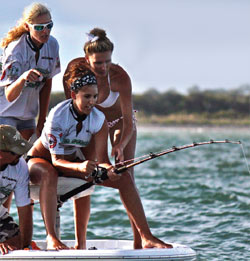 CAPTAIN KRISTA “REDFISH” TUCKER
CAPTAIN KRISTA “REDFISH” TUCKER
Krista Tucker was introduced to fishing before she can even remember. Her mom and her uncle were taking her fishing when she was still in diapers and it was just a way of life for her. Tucker learned to tie a clinch knot before she could even tie her shoes. She grew up catching Bass, Snook, and Tarpon in the Everglades in Chokoloskee and the Ten Thousand Islands, but really fell in love with the sport when she moved to Charlotte Harbor. She was on the boat every chance she got and just couldn’t get enough. At 18 years old, she got her Captains license following the inspiration that fishing was her calling. Tucker loves the competitive side of fishing and credits her dad with instilling that drive to succeed in her by not allowing her to beat him easily at childhood board games. She was good at fishing and while others in high school were medaling in Track & Field and Softball, she was entering Xtreme Redfish tournaments and fishing the Flatmasters Redfish series. Tucker’s favorite fish to target is Redfish. At first it was the hardest fish for her to figure out and now she feels like she is one with them, hence the adopted middle name. While she pre-fished for upcoming tournaments, she would often just go out and watch, not casting a line, just watching what the tide was doing, paying attention to where the fish were, and when the water started moving, she would see where the fish would go. She noticed that the fish had a route they’d follow every day and at nearly the same time every year, the school would come back to the same spot at nearly the same time. She studied their interesting habits for countless hours and really has a true appreciation for them. Tucker says, “they are a gorgeous fish to catch and I love the fight of a nice bull.” She also enjoys the reward of being able to do so.
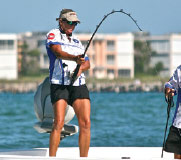 CAPTAIN LORI DEATON
CAPTAIN LORI DEATON
Capt Lori Deaton, a longtime lady angler, was always quite the tomboy growing up and enjoyed just about any outdoor activity, but the very first time she cast her line and hooked a Snook, she knew she was born to fish. Deaton says that fishing and being on the water brings her peace and provides relaxation, even when she is catching Tarpon! Tarpon are known as the Silver King to many who appreciate their beautiful silver color, their powerful fighting spirit and their dominance as the King of all sport fish. “I love everything about them, says Deaton. I think they are the most amazing creatures on earth and I live to catch them.” When Deaton is not catching tarpon, she is raising money for her charity fishing tournament, Hooked on Hope, which she established to fight breast cancer. Because Deaton has seen more women enjoying the sport of fishing over the years, she thought it would be a great idea to combine their love of fishing with a cause close to her heart. Although the tournament has many male anglers who support her registered non-profit foundation, there are a lot of teams that consist of lady anglers who wear pink wigs, have pink fishing rods and dress all in pink for the occasion which takes place in early October every year. Her tournament also invites cancer survivors and those battling the disease to the event for a day of pampering. Deaton is not only a lady angler and a licensed fishing Captain, but she has a heart of gold that is obvious from the moment you meet her. Deaton welcomes young women and girls into the sport and says that the fishing industry has much more to offer now than it did when she got her start. “Your options are endless” she says.
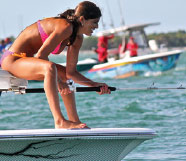 ALYSHA ARATARI
ALYSHA ARATARI
Alysha Aratari started fishing at just five years old, when her dad entered her in a tournament. She was so upset that she had not caught anything all day until the last minute when she hooked up and caught her first fish. She fell in love with fishing from that moment on and has fished ever since. Aratari says there is something about being in the outdoors with the sun beating down, the song of the whistling fishing line in the wind and the fight for the fish on the other end of a pole that she loves about fishing. Like others, Aratari says that fishing is therapeutic for her and that she is most at peace in the tranquil quietness on the water.
Aratari loves being an angler and encourages other lady anglers not to be intimidated by the once male dominated sport. “Women in fishing is on the rise,” she says. Aratari is passionate about Tarpon fishing. She loves to compete and also fishes recreationally for the explosive sport fish any chance she gets. “There is nothing like it to me, she says with a smile, for anyone who has experienced the thrill of tarpon fishing, you know exactly what I’m talking about!”
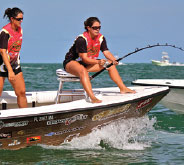 MELISSA TRAMONTANA
MELISSA TRAMONTANA
For Melissa Tramontana, fishing is an adrenaline rush. The excitement of not knowing what is lurking on the other end of your rod is what keeps her on the water every chance she gets. For Tramontana, fishing has always been a family affair. She grew up in a home on a lake fishing for Bass almost every day with her two older brothers. As they got older, they discovered the fish were a lot bigger in salt water and the trio never looked back. Learning everything she could from her brothers, who always let her tag along, she fishes with them often and even mates for her older brother who is a licensed Charter Guide. Her love of the sport is tied to the many good memories she has made through fishing and she wouldn’t trade them for the world. Growing up in a fishing and hunting family, Tramontana loves to cook her catch and enjoys a fresh fillet of fish on her plate after a good day on the water. Tramontana fishes competitively in both inshore and offshore tournaments where Grouper usually becomes the main course afterwards. She tells friends how spoiled she is knowing there’s always fresh fish in her house. Despite her love of a fresh catch, her favorite fish to tangle with is definitely the Tarpon. “They fight hard and jump high which makes it an adrenaline rush as well as a workout “, she says. “It always makes me feel like I have accomplished something when I can get one of the Silver Kings to the boat.” Tramontana looks forward to targeting other sport fish on her “list” and hopes to continue pursuing different species she has yet to land. Tramontana, at 23, hunts, fishes and scuba dives passionately. She encourages other women not to be afraid to get into the sport. “Everyone I know thinks it’s awesome when I tell them that I fish, and more often than not, I out-fish the guys,” she jokes. Fishing is definitely a big part of her life spending much of her down time on the water and providing her family with an activity to enjoy together.
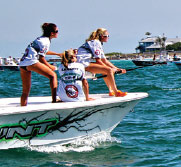 MELISSA BLAKEY
MELISSA BLAKEY
Lady Angler Melissa Blakey not only loves to fish, she is also a graduate with a degree in Environmental Science and cares about the future of fishing and the preservation of wildlife. When on the water, she learns something new and amazing on every trip. “I love the different species of fish, birds, aquatic vegetation, mammals and reptiles”, she says. “I want future generations to be able to enjoy the pristine Florida outdoors as I have been able to do.” Blakey is also a competitive tournament angler. Always hooking more fish than most of the guys on her boat, she believes that woman have more patience and better instincts so they are naturally better anglers. Blakey fishes almost every week and supports the DNA research being done for the tarpon fishery. Collecting several samples already this season from fish she has landed, she has provided them to the Florida Wildlife Commission for their Tarpon studies, a science of great interest to her.
Growing up a tomboy but still a Daddy’s girl, Blakey spent her childhood camping and Bream fishing on the Hillsborough River from her dad’s jon boat. She always loved just being on the water. She had never been exposed to saltwater fishing until five years ago when she met a young Captain who took her flats fishing for the first time and she was hooked. She seemed to have a knack for it and her ease at casting and hooking fish seemed to come naturally. She learned as much as she could and fished every opportunity she had. After eluding her on several attempts, the Snook has become her favorite fish to catch. Casting in the perfect spot in the Mangroves where they lay is challenging and when she gets one to chase her bait, it’s very rewarding. “I love to watch them jump” Blakey says. She adds that fishing has been a predominantly male sport, but women will find it to be relaxing, enjoyable and exciting and she hopes that more women will venture into the sport.
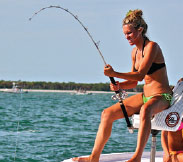 ALYSHA LANDRY
ALYSHA LANDRY
Hanging out at small freshwater lakes when she was still in a stroller, lady angler Alysha Landry was introduced to fishing by her uncle who would take her along as he passionately fished for hours. Landry says the complete tranquility she feels when she has rod and reel in hand is her favorite part of fishing. Being relaxed yet getting an intense work out from a giant Tarpon, which is her favorite fish to catch, is an adrenaline rush. “Tarpon are gorgeous,
prehistoric fish that put up a fight like you wouldn’t believe!” says Landry. “Guys are always so shocked when girls reel in a 200 pound fish by themselves.” Landry hopes that other young women will give fishing a try because the second they hook their first fish, they are hooked for life! The outdoor sport of fishing is amazing and she encourages women to get out there and learn all they can. Landry lives near the water and fishes for many types of fish that reside in her area. She is also a competitive angler and has made many great friends in tournament competition.
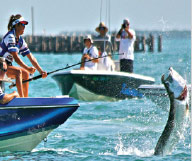 CAPTAIN JILL SAPP
CAPTAIN JILL SAPP
Growing up in Ormond Beach, Captain Jill Sapp’s Grandpa and Uncle started her fishing and blue crabbing for fun when she was just seven years old. Since they didn’t have a boat, they fished in the surf, from bridges, on piers or from the shoreline. She has been in love with fishing ever since. She credits her husband, Captain Troy Sapp with teaching her everything she knows about the kind of fishing they do together today. Sapp says she would never be able to do any of it without him. “I have been fortunate to fish from the Panhandle to the Florida Keys on all types of tackle to see firsthand what outstanding fishing opportunities Florida has to offer.” Sapp is most at home in the outdoors, whether she is on the water or in the woods. An avid hunter and angler, she loves everything about the sport. Sapp says her favorite fish is whatever is biting, but she really enjoys Snook fishing and sport fishing for Tarpon and Billfish because of their beauty and power. Sapp, who is an accomplished angler, is also well informed and knowledgeable about Florida fishing laws, regulations and pending issues. Her words of wisdom for young women who are interested in the sport is to “watch, listen and learn all you can. Ask experienced anglers for advice, attend outdoor expos, read some of the many fishing books and magazines and tune in to various fishing shows for information. Most importantly, know the laws! Know the legal size, quantity, season and take limits for each species of fish or any game you plan to harvest.” Sapp stays informed on all state fish and game regulations and issues through the National Oceanic and Atmospheric Administration and the Florida Wildlife Commission websites and often attends hearing meetings. Sapp is adamant about taking care of our precious resources for future generations and advises everyone to educate themselves about the sport.
SO MOVE OVER FELLAS, THE GIRLS OF SUMMER ARE HERE TO STAY!
Important caring male figures were key factors in introducing the sport of fishing to all our featured lady anglers at a young age. The benefits to exposing young girls to outdoor sports such as fishing and hunting are many. Accomplishing anything builds self-esteem. Fishing is a sport that allows multiple repeated success with each catch. A feeling of confidence in the ability to use tools such as rod and reel, firearm or bow to become successful at the sport starts with being comfortable using them. Women are not only becoming more prominent in the sport as successful competitors, anglers and business women today but are often more compassionate about the conservation of wildlife and the environments which create stability for future generations. Won’t it be great when our daughters are being taught the techniques of fishing and hunting and an appreciation for the outdoors not only by their dads, brothers and uncles but by their moms, sisters and aunts as well!
Sheila Tramontana is a photographer and outdoor enthusiast who is a native Floridian. Introduced to fishing by a long heritage of family who enjoyed the sport, it was one of her favorite outdoor activities as a child. Sheila now photographs professional fishing tournaments, as well as other outdoor sports and her portfolio contains Florida scenery and wildlife photography for home and office. For more information, you can visit her website at www.sheilatphotography.com or find her on Facebook and Pinterest.
PERMIT WRECKIN
It was a Monday and we were already staying at the beach. I had my nieces, a friend and a boyfriend that wanted to go catch some fish. The seas were flat calm and it was sunny so I said, “let’s go see if we can get on the Permit”. I dropped the Calcutta in at O’Neill’s Marina, took on a little fuel, some snacks, drinks, put about 30 frisky blue crabs in the well and headed to the spot.
When we got there the water was nice and clear and bait and barracudas were all over the place. We made one drift but did not see the first permit, so we anchored and decided to wait for them to come to us. When we came tight on the anchor, Melissa said, hey what is that? I went back to the stern and about five feet down a dozen 20 to 40 pound permit swam underneath the back of the boat. Great, they are here. We baited up the small crowder/shimano spinning rods with the crabs and out they went. Five, ten, fifteen minutes go by and nothing happens, we don’t even see another fish. We say the hell with this; lets pull the hook and go back to drifting. We motor back up current of where we think the fish should be and toss out all the lines again. Right  about the time that the last line hits the water, I hear Andrew “Hambone” Hammonds, say, “hey, I think I got something on ”. Andrew started reeling, reel reel reel, and once he caught up to the fish the Permit took off on a great run. Twenty-five minutes later we had a nice 25-pound permit on board, it was Hammy’s first Permit ever.
about the time that the last line hits the water, I hear Andrew “Hambone” Hammonds, say, “hey, I think I got something on ”. Andrew started reeling, reel reel reel, and once he caught up to the fish the Permit took off on a great run. Twenty-five minutes later we had a nice 25-pound permit on board, it was Hammy’s first Permit ever.
The first fish had taken us a pretty long distance from where the school should be, so we motored back up current and started tossing out crabs again. We did not even get the last crab in the water when Haley’s line started peeling off the spool. This fish started to head out in the same direction as Hambone’s then made a u-turn and went straight back to the structure. There was nothing Haley could do but hope the fish did 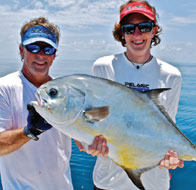 not go deep, but it did and cut her off.
not go deep, but it did and cut her off.
We quickly threw out more crabs and within a minute Melissa had another one on. This was a little bit bigger fish and luckily it headed out to deeper water with zero structure around. Melissa fought the Permit for about 30 minutes, a nice 28 pounder. With one in the box for dinner, we wanted to tag this one and get a fin clip for DNA to assist in the “Project Permit” study.
This study, in partnership with Bonefish Tarpon & Trust and Costa Del Mar, is part of a new Permit research at the FWC – Fish and Wildlife Research Institute (FWRI). The DNA samples will be used to determine if Permit throughout Florida are from a unit stock.
Contact Captain Harry Conner at: www.hookemharry.com or by cell at 813-388-3285.
The Bottom Has a Rocky Reputation
Gag grouper (Mycteroperca microlepis) have been under close watch and monitoring by the NOAA fisheries services. In 1990, the minimum length for Gag grouper was 20”, and the total bag limit per person was 5 fish. According to the National Marine Fisheries, the first Gag Grouper stock assessment was in 1994, and this concluded that there was a better population than anticipated. In 1998, The Reef Fish Stock Assessment Panel assessed the 1997 Gag stock population, and did not consider Gags to be over fished, but this is when the council considered temporary closures, to protect the spawning of Grouper. In June 2000, the recreational size limit was increased to 22”, and the commercial sale of Gag Grouper, Black Grouper, and Red grouper was prohibited each year from Feb. 15th, to March 15th, which is the peak of Grouper spawning season. The current bag limit for Gag Grouper is 2 fish per person, with an aggregate total of 4 Grouper per person, if you run into keeper Red Grouper. Example: 2 Gags, 2 Reds per person, or 4 Reds per person, or 3 Reds and one Gag per person. No more than 2 Gags per person. We have witnessed no depletion of the population, and the Captain says Gag fishing is better than ever.
With that said, Gag Grouper is on the menu! Until October 31st that is. My job as a First mate on a local offshore fishing boat, The Reef Chief, has given me a first class look into the species and the art of Gag grouper fishing. This is one of the most sought after fish by anglers, and also some of the most expensive and delicious meat dwelling on the rock ledges throughout the Gulf of Mexico.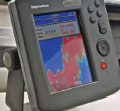
Over here in North West Central Florida, lies “The Little City by the river”, Port Richey. Locals call it the Cottee river. Every day in July we departed from the river and have been booked on trips to pull Grouper from the hard bottom in many different depths of water. The length of the charter dictates how far the boat can run out for the trip. From 30-60ft and everything in between, we’ve had many banner days where the Gags will chew as if it was a bumpy winter day, but in the middle of summer! Even some stud Red Grouper have made appearances in as little as 35ft of water with some of these fish weighing over 10 pounds!
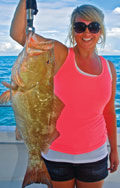 At the Helm aboard The Reef Chief, is a lifetime Florida native, and a 20+ year charter guide, Captain Mike Teegarden. He’s taught me that the most crucial part of catching Gags is being able to position the stern of your vessel right on top of your favorite break or ledge. You cant go over the break, however, and depending on the tide you even have to consider which way the lines going to run off the stern so the baits will drop right in front of the fish. Reds will venture further from the exact spot/break, but the gags hang pretty close to where they feel safe, which is near the razor sharp rocks.
At the Helm aboard The Reef Chief, is a lifetime Florida native, and a 20+ year charter guide, Captain Mike Teegarden. He’s taught me that the most crucial part of catching Gags is being able to position the stern of your vessel right on top of your favorite break or ledge. You cant go over the break, however, and depending on the tide you even have to consider which way the lines going to run off the stern so the baits will drop right in front of the fish. Reds will venture further from the exact spot/break, but the gags hang pretty close to where they feel safe, which is near the razor sharp rocks.
The very successful rod/reel combinations that we provide are Penn Senator 4/0 reels and custom built broom sticks if you will, to haul the fish away from the coral which is right where they head to after they feel tension. Pulling up on the rod does no good, A.) Because we use circle hooks, and B.) The fish will take all the stretch from the line and be under a piece of bottom in an instant. The most imperative part is to use the reel as a wench and “JUST REEL LIKE HELL!” Once he is 5-10ft off the bottom you own the fish and can enjoy the pull from our common 10+ pound fish. 80# Suffix line is spooled on all of our reels, with a very effective knocker rig. One primary key with the knocker rig is giving extra slack when you hit the bottom, to allow the bait to float away from the sinker.
Our main focus is the Grouper, but many other species appear behind the boat in our natural chum slick from all of our sardines getting knocked off. Cobia are a frequent visitor off the stern, curious as to where all this free food is coming from. Every Cobia we have had behind the boat eats a flat lined sardine and what a bonus fish for the customers. We also have a great population of huge Key West Snapper, AKA the Grunts, which is also an excellent white meat fish. Catching a few Grunt always fires up the Grouper bite as they live together, no Grunt = no Grouper. Several sharks also have come right off the stern, including a Hammerhead every bit of 9ft and 450 pounds, what a sight!
The fish are chewing hard, 80% of the time we are meeting our boat limit. So get out and get catching! The speculation for the rest of the season seems very optimistic.
To book a trip with Capt. Mike Teegarden aboard The Reef Chief, visit www.thereefchiefcharters.com or www.facebook.com/ReefChiefCharters.
NIGHT CRAWLERS
With Florida’s hottest months approaching, many anglers who work on the water or outdoors in general, are looking for other options that allow them to stay out of the UV rays for personal recreation. In order to accomplish this, we change a few tactics, and load up the gear as the sun gets low. We grab a few lights and set out to fish in the darkness.
Fishing docks and bridges has always been a long time favorite of mine. Structure provides a shelter for several species like the Snook. They like to hide out in the pilings providing a challenge for the angler. In addition to the fish, every structure in the saltwater attracts oysters and barnacles that attach directly to pilings. The sharp shells of these creatures can slice through braided line like it was butter. Considering all of these obstacles, plan your rod/reel/line combo accordingly. You have to have a rod stout enough to turn a fish that is headed toward the pilings, a reel that will hold heavy braid and at least a 30# leader. I sometimes beef my leader up to 40# when I know serious fish are home. Always be ready to palm the spool as a last resort to turn the fish’s head away from structure.
An important consideration, when planning a trip, is taking advantage of fishing the fastest part of a moving tide. This time of year can be great with bigger tides in the evening and into the night. If you can catch a full moon tide, it’s the best chance of the month for the most productive bite at night. The full moons in the first week of June and July hold huge outgoing tides. The new moons that fall on the 19th day of June and July also move the largest concentration of water for the month. Another thing I look for when paddling down a canal system that is littered with hundreds of docks is lights. Lights on the dock, or underwater, can set one group of pilings apart from all the others. I often observe bait schools drawn in by the overhung, or underwater illumination. Bends, or “bottlenecks”, in canals or rivers where the tide runs more quickly are also good areas to fish. 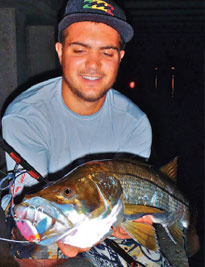
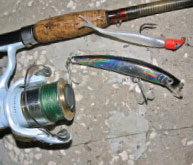 Another area that I will be targeting very soon is the beach. The fish are currently making their move from rivers systems out into open waters. Many sightings of good fish have already been reported right off the beach. When fishing in the daytime, big shadows sitting in the troughs is what you are looking for and those fish provide great practice for sight fishing. At night, fishing the moving water where fish lay in wait for a bait to be funneled through with the tide is another technique that I like. An old fisherman once told me “Work your bait with the tide”. This approach makes your lure look like another piece of bait sweeping away in the tide. Now that you know where to find fish and the best time to fish, you only need to know what to fish with. I will try to share some baits that have been the most productive for me. With all of the whitebait around, if you can catch it and keep it alive, I am sure you can spark a feeding frenzy. I am often on land, or in a kayak, so I prefer the ease of artificial baits. First and foremost, the thrashing of a Rapala X-rap, or a Yo-zuri is a top choice. The rattling and either the slow suspending, or slow floating motion after you jerk the bait around, is irresistible to fish.
Another area that I will be targeting very soon is the beach. The fish are currently making their move from rivers systems out into open waters. Many sightings of good fish have already been reported right off the beach. When fishing in the daytime, big shadows sitting in the troughs is what you are looking for and those fish provide great practice for sight fishing. At night, fishing the moving water where fish lay in wait for a bait to be funneled through with the tide is another technique that I like. An old fisherman once told me “Work your bait with the tide”. This approach makes your lure look like another piece of bait sweeping away in the tide. Now that you know where to find fish and the best time to fish, you only need to know what to fish with. I will try to share some baits that have been the most productive for me. With all of the whitebait around, if you can catch it and keep it alive, I am sure you can spark a feeding frenzy. I am often on land, or in a kayak, so I prefer the ease of artificial baits. First and foremost, the thrashing of a Rapala X-rap, or a Yo-zuri is a top choice. The rattling and either the slow suspending, or slow floating motion after you jerk the bait around, is irresistible to fish.
In certain situations floating sea grass will now allow two treble hooks to slash through the water in the proper motion, so switching to a bait with a single hook where grass can be twitched free is necessary.
A DOA Bait Buster is a second favorite of mine. These blend right in with finger mullet, and most bites come from a solid fish. Other large, light colored jerk baits have been showing results when rigged on a heavier jig head of least 1/4oz in size. This gives that jerk-bait a more erratic action that a Snook will zero in on.
Hog Wild
July and August are usually the two months that I split my time between Tarpon fishing and getting my hunting grounds ready for deer season. On the weekends that the weather looks bad for Tarpon fishing, I am off to the hunt camp to plant food plots, move tree stands and prepare everything else necessary to be ready for the season when I can enjoy a quiet, cold morning in a tree stand. I am very fortunate to have my own property to hunt on and thus I do not have to contend with public hunting areas. Having my own place to hunt allows me to pick and chose what to plant and where to plant it. This year we decided to plant a few acres of corn, rather than the usual winter wheat or rye fields. Now I am having second thoughts about that decision. I think that next year we will go back to planting winter wheat and rye plus maybe some turnips and soybeans because our cornfields were completely destroyed in less than a week.
After working very hard to till the ground and plant (expensive) corn and fertilize, (which was even more expensive) the wild hogs found our field. We had six-foot high corn with big healthy stalks and cobs growing because of all the rain we got right after planting. Our time to sit back and feel proud of ourselves didn’t last long. Once the wild hogs found the corn, the field was devastated within three days. When I say devastated, I mean gone, wiped out, flat, not a stalk standing and the entire field smelled like a pigsty. Now we have no choice but to till it back up and re-plant with winter wheat and rye and peas, fortunately, by the time it begins to look good it will be hunting season and I will have my crosshairs on a few piggies if they dare to come near it.
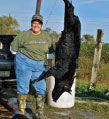
There are three types of hogs; these include free-ranging domestic stock, Eurasian wild boar and hybrids of the domestic and Eurasian boars. The Eurasian boars were brought to the United States by Hernando De Soto and Ponce de Leon in the early 1500’s. Typically what you see is a feral hog, which is a mixture of all hogs that have escaped capture. It is rare to find a Eurasian boar that has not bred with a domestic or feral hog here in Florida or Georgia. I consider all of them to be wild hogs. They can be found in every county of Florida and in at least 35 other states, including some provinces in Canada. Florida has the second largest hog population with only Texas having more. There are more than 2 million wild hogs in the southeastern United States and this population is growing fast.
The hog’s diet consists of; well let’s just say it is easier to list what they don’t eat rather than what they will eat. They are opportunistic eaters and will eat a variety of grasses, roots, leaves, seeds and fruits and even some small animals including worms, insects, crustaceans, mammals and reptiles. They sure liked my corn field. The devastation of crops in farmland areas is really getting out of hand and it is very difficult to control. Trapping or hunting is the only way to control the population growth and the devastation that wild hogs are causing and these are not able to make a significant dent in their population. I once thought that the world would eventually be taken over by fire ants, but I now suspect that the wild hog is more likely to be the last animal on earth, unless he eats himself out of h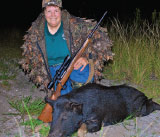 ouse and home.
ouse and home.
A wild hog becomes sexually mature by the age of 6 months old and they usually have a small first liter of 1 to 7 piglets and then larger litters from then on. The hogs usually give birth twice a year to litters with as many as a dozen piglets. Humans are the main predators of wild hogs; large carnivores such as alligators, bears and Florida panthers may be capable of preying on them, but usually not on adult hogs. Not only do the wild hogs devastate crops, destroy land and contaminate waterways, they also compete with other wild animals for their hard mast foods. When food sources dry up other game animals such as deer, turkey and squirrels suffer as a result of the piggish wild hog’s gorging on their foods. If you want to keep a healthy herd of deer on your property, you will also have to manage the population of wild hogs on your land, either trapping or hunting them. If, like me, you do not like the taste of wild hogs, there are many places that accept the meat for charity food drives. If you trap the hogs there are many hunting preserves that would love to accept the hogs that have been trapped.
Florida allows hunting for wild hogs year round 24/7. Before hunting hogs at night or on private lands it is always a good idea to 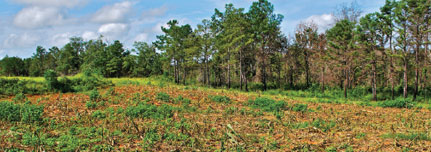 contact the Florida Wildlife Commission for regulations and permits. You can contact or find information about hog hunting and special permitting at www.myfwc.com. Many farmers would welcome a responsible hunter to help eradicate hogs on their land and would allow you to take a few hogs from their land. Never hunt private land without permission and as always know your regulations and especially be safe while hunting. Let’s go
contact the Florida Wildlife Commission for regulations and permits. You can contact or find information about hog hunting and special permitting at www.myfwc.com. Many farmers would welcome a responsible hunter to help eradicate hogs on their land and would allow you to take a few hogs from their land. Never hunt private land without permission and as always know your regulations and especially be safe while hunting. Let’s go

